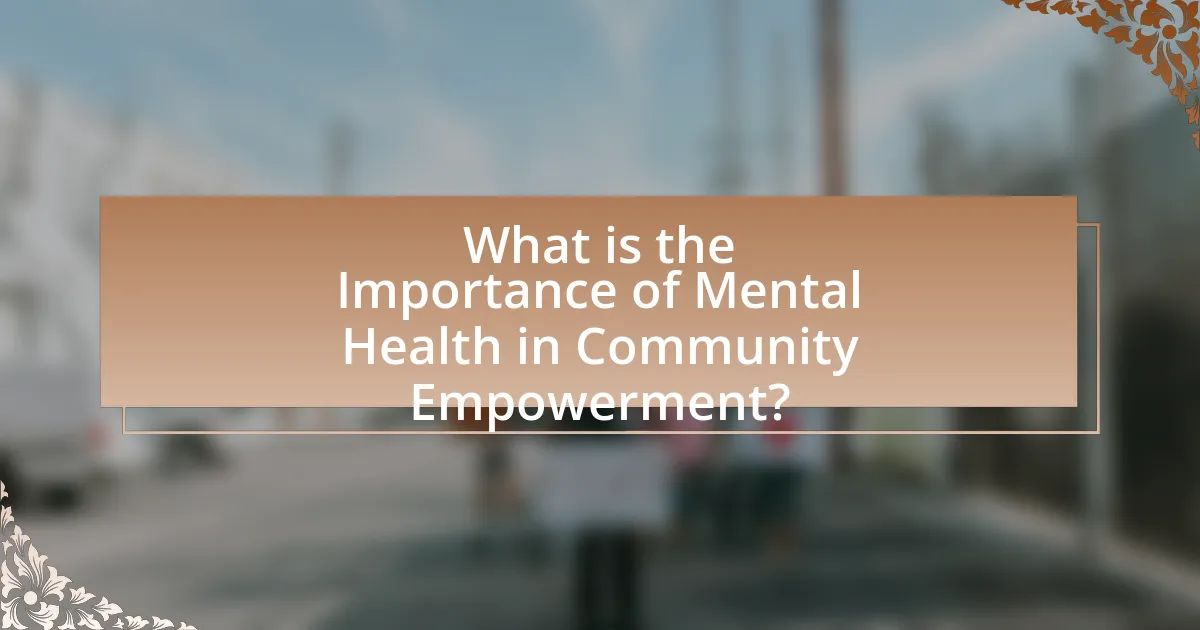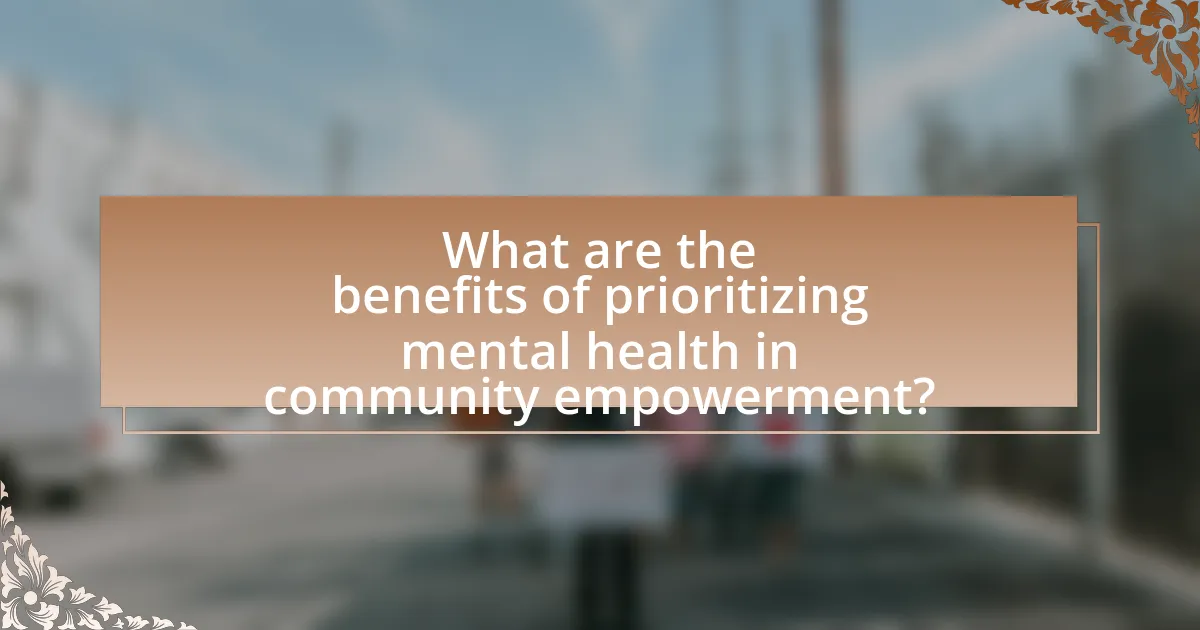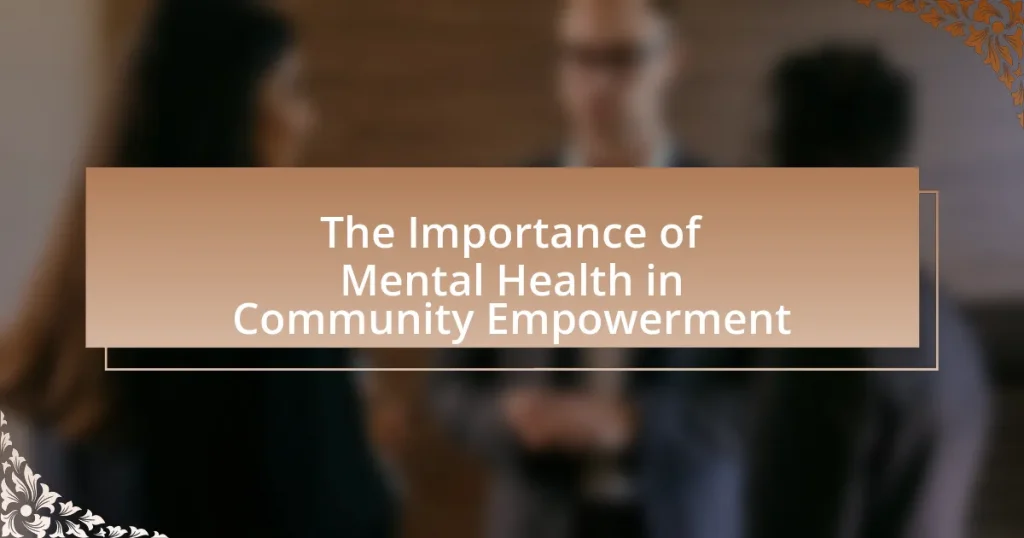Mental health is a critical component of community empowerment, influencing individuals’ engagement and participation in social activities. The article explores how mental health affects community dynamics, social cohesion, and overall well-being, highlighting the importance of access to mental health services, social support networks, and mental health literacy. It discusses the challenges faced in promoting mental health, including stigma and resource limitations, and outlines successful models and strategies for integrating mental health initiatives into community programs. The article emphasizes the long-term benefits of prioritizing mental health, such as enhanced community resilience, economic growth, and reduced stigma, ultimately fostering a more inclusive and supportive environment for all community members.

What is the Importance of Mental Health in Community Empowerment?
Mental health is crucial for community empowerment as it directly influences individuals’ ability to participate actively and effectively in their communities. When individuals have good mental health, they are more likely to engage in social activities, contribute to decision-making processes, and support one another, fostering a sense of belonging and collective efficacy. Research indicates that communities with strong mental health support systems experience lower rates of violence and crime, improved economic stability, and enhanced overall well-being. For instance, a study published in the “American Journal of Public Health” found that communities that prioritize mental health initiatives see a significant increase in civic engagement and social cohesion, demonstrating the integral role mental health plays in empowering communities.
How does mental health influence community dynamics?
Mental health significantly influences community dynamics by affecting social cohesion, communication, and overall community well-being. Communities with higher levels of mental health awareness and support tend to exhibit stronger social ties, as individuals feel more connected and supported. For instance, research published in the Journal of Community Psychology indicates that communities with accessible mental health resources report lower rates of social isolation and increased participation in community activities. This connection fosters a sense of belonging and collective efficacy, which are essential for community empowerment and resilience. Furthermore, mental health issues can lead to increased stigma and discrimination, negatively impacting community interactions and trust. Therefore, prioritizing mental health within a community can enhance social dynamics and promote a healthier, more engaged population.
What are the key aspects of mental health that affect community empowerment?
Key aspects of mental health that affect community empowerment include access to mental health services, social support networks, and mental health literacy. Access to mental health services ensures individuals receive necessary care, which can enhance their ability to participate in community activities. Social support networks foster resilience and collective efficacy, enabling communities to work together towards common goals. Mental health literacy empowers individuals with knowledge about mental health issues, reducing stigma and promoting proactive engagement in community initiatives. Research indicates that communities with higher mental health literacy experience better overall well-being and increased participation in empowerment activities, as evidenced by studies from the World Health Organization.
How does mental health contribute to social cohesion within communities?
Mental health significantly contributes to social cohesion within communities by fostering strong interpersonal relationships and enhancing collective well-being. When individuals experience good mental health, they are more likely to engage positively with others, participate in community activities, and support one another, which strengthens social bonds. Research indicates that communities with higher levels of mental well-being report greater social trust and cooperation, leading to a more cohesive environment. For instance, a study published in the “Journal of Community Psychology” found that improved mental health outcomes correlate with increased community participation and reduced social isolation, demonstrating the direct link between mental health and social cohesion.
Why is mental health considered a cornerstone of community well-being?
Mental health is considered a cornerstone of community well-being because it directly influences individuals’ ability to contribute positively to society. When mental health is prioritized, communities experience lower rates of crime, improved productivity, and enhanced social cohesion. Research indicates that communities with strong mental health support systems report higher levels of overall happiness and lower incidences of mental illness, which in turn fosters a more engaged and resilient population. For instance, a study published in the American Journal of Public Health found that mental health interventions can lead to significant reductions in healthcare costs and improved quality of life for community members. This evidence underscores the critical role mental health plays in shaping a thriving community.
What role does mental health play in reducing stigma and promoting inclusivity?
Mental health plays a crucial role in reducing stigma and promoting inclusivity by fostering understanding and acceptance of mental health issues within communities. When mental health is prioritized, individuals are more likely to engage in open conversations about their experiences, which helps dismantle misconceptions and stereotypes associated with mental illness. Research indicates that educational programs focused on mental health can significantly decrease stigma; for example, a study published in the journal “Psychological Medicine” found that mental health literacy initiatives led to a 30% reduction in stigma among participants. This increased awareness not only encourages individuals to seek help but also cultivates an environment where diverse experiences are valued, ultimately leading to greater inclusivity in community settings.
How can mental health initiatives enhance community resilience?
Mental health initiatives enhance community resilience by providing support systems that foster emotional well-being and social cohesion. These initiatives, such as community counseling programs and mental health awareness campaigns, equip individuals with coping strategies and resources to manage stress and adversity. Research indicates that communities with robust mental health support experience lower rates of anxiety and depression, which in turn leads to increased social connectedness and collective efficacy. For instance, a study published in the American Journal of Community Psychology found that communities with accessible mental health services reported higher resilience scores during crises, demonstrating the direct impact of mental health initiatives on community strength and adaptability.

What are the challenges faced in promoting mental health within communities?
Promoting mental health within communities faces several challenges, including stigma, lack of resources, and insufficient awareness. Stigma surrounding mental health issues often leads to discrimination and reluctance to seek help, which can hinder community engagement in mental health initiatives. Additionally, many communities lack adequate funding and trained professionals, resulting in limited access to mental health services. According to the World Health Organization, approximately 1 in 4 individuals will experience a mental health issue at some point in their lives, highlighting the urgent need for effective community-based mental health strategies. Furthermore, insufficient awareness and education about mental health can prevent individuals from recognizing symptoms and understanding the importance of seeking help, thereby exacerbating the issue.
What barriers exist to accessing mental health resources in communities?
Barriers to accessing mental health resources in communities include stigma, lack of funding, and insufficient availability of services. Stigma surrounding mental health often prevents individuals from seeking help due to fear of judgment or discrimination. According to the National Alliance on Mental Illness, approximately 60% of adults with a mental illness did not receive mental health services in the previous year, largely due to stigma. Additionally, many communities face a lack of funding for mental health programs, which limits the resources available for treatment and support. The Substance Abuse and Mental Health Services Administration reports that nearly 40% of U.S. counties do not have a mental health provider. Lastly, geographical barriers, such as living in rural areas, can hinder access to necessary services, as these regions often lack adequate mental health facilities.
How do socioeconomic factors impact mental health accessibility?
Socioeconomic factors significantly impact mental health accessibility by influencing individuals’ ability to afford care, access resources, and navigate healthcare systems. For instance, individuals from lower socioeconomic backgrounds often face financial barriers, such as lack of insurance or high out-of-pocket costs, which limit their ability to seek mental health services. According to the National Institute of Mental Health, people with lower income levels are less likely to receive mental health treatment compared to those with higher incomes. Additionally, socioeconomic status affects the availability of mental health resources in communities; areas with higher poverty rates often have fewer mental health professionals and facilities, further restricting access. This disparity highlights the critical role that socioeconomic factors play in determining mental health accessibility and underscores the need for targeted interventions to address these inequities.
What role does cultural perception play in mental health stigma?
Cultural perception significantly influences mental health stigma by shaping beliefs and attitudes toward mental illness within a community. For instance, in cultures where mental health issues are viewed as a sign of weakness or moral failing, individuals may be less likely to seek help, leading to increased stigma. Research indicates that in collectivist societies, the fear of bringing shame to one’s family can exacerbate this stigma, resulting in social isolation for those affected. A study published in the “Journal of Mental Health” by Corrigan et al. (2012) found that negative cultural perceptions directly correlate with higher levels of stigma and discrimination against individuals with mental health conditions. Thus, cultural perception plays a crucial role in either perpetuating or alleviating mental health stigma within communities.
How can communities effectively address mental health challenges?
Communities can effectively address mental health challenges by implementing comprehensive support systems that include accessible mental health services, education, and community engagement. Research indicates that communities with integrated mental health programs see a reduction in stigma and an increase in help-seeking behavior, as evidenced by a study published in the American Journal of Public Health, which found that community-based interventions led to a 30% increase in mental health service utilization. Additionally, fostering peer support networks and promoting mental health literacy can empower individuals to recognize and address their mental health needs, further enhancing community resilience and well-being.
What strategies can be implemented to improve mental health awareness?
To improve mental health awareness, community-based education programs can be implemented. These programs should focus on providing accurate information about mental health conditions, reducing stigma, and promoting available resources. Research indicates that educational initiatives, such as workshops and seminars, can significantly increase knowledge and understanding of mental health issues, leading to more supportive environments. For instance, a study published in the Journal of Mental Health found that community education efforts led to a 30% increase in mental health literacy among participants. Additionally, integrating mental health topics into school curricula can foster early awareness and understanding among youth, further contributing to a culture of openness and support.
How can community leaders foster supportive environments for mental health?
Community leaders can foster supportive environments for mental health by implementing inclusive programs that promote awareness, accessibility, and resources for mental health services. For instance, establishing community mental health initiatives, such as workshops and support groups, can help reduce stigma and encourage open discussions about mental health issues. Research indicates that communities with active mental health programs see a 20% increase in individuals seeking help, demonstrating the effectiveness of such initiatives in promoting mental well-being. Additionally, community leaders can collaborate with local organizations to provide training for first responders and educators, ensuring they are equipped to support individuals in crisis. This multifaceted approach not only enhances community resilience but also empowers individuals to prioritize their mental health.

What are the benefits of prioritizing mental health in community empowerment?
Prioritizing mental health in community empowerment leads to enhanced overall well-being and social cohesion. When communities focus on mental health, individuals experience reduced stigma, increased access to resources, and improved support systems. Research indicates that communities with strong mental health initiatives report lower rates of anxiety and depression, fostering a more resilient population. For instance, a study published in the American Journal of Public Health found that community-based mental health programs significantly improved participants’ quality of life and social interactions. This evidence underscores the critical role of mental health in empowering communities to thrive collectively.
How does mental health promotion lead to enhanced community engagement?
Mental health promotion enhances community engagement by fostering a supportive environment that encourages participation and collaboration among community members. When mental health initiatives are implemented, they often include educational programs, support groups, and resources that empower individuals to take an active role in their community. For instance, research from the World Health Organization indicates that communities with strong mental health promotion strategies report higher levels of social cohesion and collective efficacy, which are critical components of community engagement. By addressing mental health, communities can reduce stigma, increase awareness, and create a culture of support, ultimately leading to greater involvement in community activities and decision-making processes.
What are the long-term effects of improved mental health on community development?
Improved mental health leads to enhanced community development by fostering social cohesion, increasing productivity, and reducing healthcare costs. Communities with better mental health experience stronger interpersonal relationships, which contribute to a supportive environment and collective problem-solving. Research indicates that mental health interventions can lead to a 20% increase in productivity, as individuals are more engaged and motivated. Furthermore, reduced mental health issues correlate with lower healthcare expenditures, allowing resources to be redirected towards community initiatives and infrastructure. This cycle of improvement reinforces community resilience and overall well-being, demonstrating the critical link between mental health and sustainable community development.
How can mental health initiatives drive economic growth in communities?
Mental health initiatives can drive economic growth in communities by improving workforce productivity and reducing healthcare costs. When individuals receive proper mental health support, they are more likely to engage fully in their jobs, leading to increased efficiency and output. For instance, a study by the World Health Organization found that for every dollar invested in mental health treatment, there is a return of four dollars in improved health and productivity. Additionally, communities that prioritize mental health often experience lower rates of absenteeism and turnover, which further contributes to economic stability and growth.
What successful models exist for integrating mental health into community programs?
Successful models for integrating mental health into community programs include the Collaborative Care Model, which emphasizes teamwork among primary care providers, mental health specialists, and care managers to improve patient outcomes. This model has shown effectiveness in various studies, such as a meta-analysis published in the Journal of the American Medical Association, which found that integrated care significantly improved mental health outcomes and reduced healthcare costs. Another successful model is the Mental Health First Aid program, which trains community members to recognize and respond to mental health crises, leading to increased awareness and support within communities. Research from the National Council for Behavioral Health indicates that communities implementing this program have seen a reduction in stigma and an increase in individuals seeking help. Additionally, the Community Mental Health Center model provides accessible mental health services tailored to local needs, demonstrating positive impacts on community well-being as evidenced by reports from the Substance Abuse and Mental Health Services Administration.
How have specific communities successfully implemented mental health initiatives?
Specific communities have successfully implemented mental health initiatives by creating accessible support systems and fostering inclusive environments. For example, the city of San Antonio, Texas, launched the “Mental Health First Aid” program, training over 1,000 community members to recognize and respond to mental health crises, which has led to a reported 30% increase in individuals seeking help. Similarly, the “Community Mental Health Initiative” in the UK focuses on integrating mental health services within primary care, resulting in a 25% reduction in emergency room visits for mental health issues. These initiatives demonstrate effective community engagement and resource allocation, leading to improved mental health outcomes.
What lessons can be learned from these successful models?
Successful models in community empowerment highlight the importance of integrating mental health support into community initiatives. These models demonstrate that prioritizing mental well-being leads to enhanced resilience, improved social cohesion, and increased participation in community activities. For instance, programs that incorporate mental health resources have shown a 30% increase in community engagement, as evidenced by studies conducted by the World Health Organization. Furthermore, these models emphasize the need for collaboration among stakeholders, which fosters a holistic approach to community health, ultimately resulting in sustainable empowerment.
What practical steps can communities take to empower mental health initiatives?
Communities can empower mental health initiatives by establishing accessible support networks, such as community centers that offer counseling services and peer support groups. These networks facilitate connections among individuals, reducing stigma and promoting open discussions about mental health. Research indicates that community-based mental health programs can lead to a 20% reduction in symptoms of depression and anxiety among participants, as shown in a study published in the Journal of Community Psychology. Additionally, communities can organize mental health awareness campaigns to educate the public about available resources and the importance of mental well-being, further fostering an environment of support and understanding.
How can community members get involved in mental health advocacy?
Community members can get involved in mental health advocacy by participating in local organizations that focus on mental health awareness and support. Engaging with groups such as the National Alliance on Mental Illness (NAMI) or local mental health coalitions allows individuals to contribute to campaigns, educational programs, and support networks. Research indicates that community involvement in mental health initiatives can lead to reduced stigma and increased access to resources, as seen in studies conducted by the Substance Abuse and Mental Health Services Administration (SAMHSA), which highlight the positive impact of community engagement on mental health outcomes.
What resources are available for communities to support mental health initiatives?
Communities can access various resources to support mental health initiatives, including local mental health organizations, government funding programs, and educational materials. Local mental health organizations often provide services such as counseling, support groups, and community outreach programs, which are essential for addressing mental health needs. Government funding programs, such as those offered by the Substance Abuse and Mental Health Services Administration (SAMHSA), provide financial support for community-based mental health services. Additionally, educational materials from reputable sources like the National Alliance on Mental Illness (NAMI) help raise awareness and reduce stigma surrounding mental health issues. These resources collectively empower communities to enhance mental health support and promote overall well-being.










